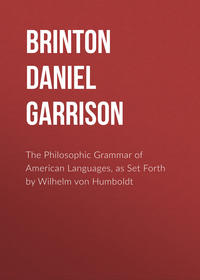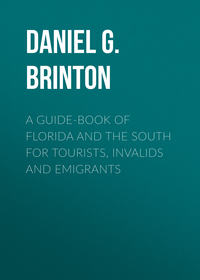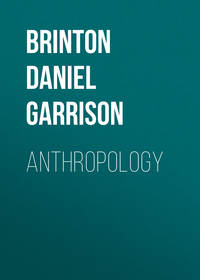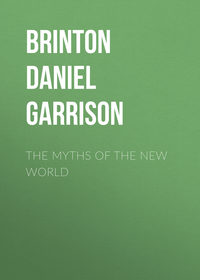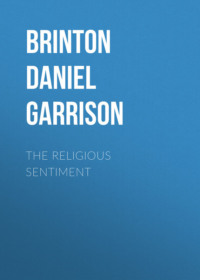
American Hero-Myths: A Study in the Native Religions of the Western Continent
[Footnote 85: Anales del Museo Nacional, Tom. ii, p. 367.]
[Footnote 86: "Segun los Anales de Cuauhtitlan el ocelotl es el cielo manchado de estrellas, como piel de tigre." Anales del Mus. Nac., ii, p. 254.]
[Footnote 87: Codex Telleriano-Remensis, plate xiv.]
[Footnote 88: Sahagun, Historia, Lib. i, cap. v. Torquemada, Monarquia Indiana, Lib. vi, cap. xxiv.]
[Footnote 89: "Queçalcoatl y por otro nombre yagualiecatl." Ramirez de Fuen-leal, Historia, cap. i. Yahualli is from the root yaual or youal, circular, rounding, and was applied to various objects of a circular form. The sign of Quetzalcoatl is called by Sahagun, using the native word, "el Yoel de los Vientos" (Historia, ubi supra).]
[Footnote 90: "Se llaman (á Quetzalcoatl) Señor de el Viento * * * A este le hacian las yglesias redondas, sin esquina ninguna." Codex Telleriano-Remensis. Parte ii, Lam. ii. Describing the sacred edifices of Mexico, Motolinia says: "Habio en todos los mas de estos grandes patios un otro templo que despues de levantada aquella capa quadrada, hecho su altar, cubrianlo con una pared redonda, alta y cubierta con su chapital. Este era del dios del aire, cual dijimos tener su principal sella en Cholollan, y en toda esta provincia habia mucho de estos. A este dios del aire llamaban en su lengua Quetzalcoatl," Historia de los Indios, Epistola Proemial. Compare also Herrera, Historia de las Indias Occidentals, Dec. ii, Lib. vii, cap. xvii, who describes the temple of Quetzalcoatl, in the city of Mexico, and adds that it was circular, "porque asi como el Aire anda al rededor del Cielo, asi le hacian el Templo redondo."]
[Footnote 91: The Aztec words are Quiahuitl teotl, quiahuitl, rain, teotl, god; Tonacaquahuitl, from to, our, naca, flesh or life, quahuitl, tree; Chicahualizteotl, from chicahualiztli, strength or courage, and teotl, god. These names are given by Ixtlilxochitl, Historia chichimeca, cap. i.]
[Footnote 92: Ramirez de Fuen-leal, Historia de los Mexicanos, cap. ii.]
[Footnote 93: Tlalli, earth, oc from octli, the native wine made from the maguey, enormous quantities of which are consumed by the lower classes in Mexico at this day, and which was well known to the ancients. Another derivation of the name is from tlalli, and onoc, being, to be, hence, "resident on the earth." This does not seem appropriate.]
[Footnote 94: From chalchihuitl, jade, and cueitl, skirt or petticoat, with the possessive prefix, i, her.]
[Footnote 95: See E.G. Squier, Observations on a Collection of Chalchihuitls from Central America, New York, 1869, and Heinrich Fischer, Nephrit und Jadeit nach ihrer Urgeschichtlichen und Ethnographischen Bedeutung, Stuttgart, 1880, for a full discussion of the subject.]
[Footnote 96: Codex Telleriano-Remensis, Pt. ii, Lam. ii.]
[Footnote 97: See above, chapter iii, §3]
[Footnote 98: Torquemada, Monarquia Indiana, Lib. vi, cap. xxiv.]
[Footnote 99: Sahagun, Hisioria, Lib. ii, cap. i. A worthy but visionary Mexican antiquary, Don J.M. Melgar, has recognized in Aztec mythology the frequency of the symbolism which expresses the fertilizing action of the sky (the sun and rains) upon the earth. He thinks that in some of the manuscripts, as the Codex Borgia, it is represented by the rabbit fecundating the frog. See his Examen Comparativo entre los Signos Simbolicos de las Teogonias y Cosmogonias antiguas y los que existen en los Manuscritos Mexicanos, p. 21 (Vera Cruz, 1872).]
[Footnote 100: Codex Vaticanus, Pl. xv.]
[Footnote 101: Codex Telleriano Remensis, Pl. xxxiii.]
[Footnote 102: Mendieta, Hist. Eclesiastia Indiana, Lib. ii, cap. xiv. "Una tonta ficcion," comments the worthy chronicler upon the narrative, "como son las demas que creian cerca de sus dioses." This has been the universal opinion. My ambition in writing this book is, that it will be universal no longer.]
[Footnote 103: Sahagun, Historia, Lib. iii, cap. iii.]
[Footnote 104: Veitia, cap. xvii, in Kingsborough.]
[Footnote 105: Sahagun, Historia, Lib. vi, cap. xxv. The bisexual nature of the Mexican gods, referred to in this passage, is well marked in many features of their mythology. Quetzalcoatl is often addressed in the prayers as "father and mother," just as, in the Egyptian ritual, Chnum was appealed to as "father of fathers and mother of mothers" (Tiele, Hist. of the Egyptian Religion, p. 134). I have endeavored to explain this widespread belief in hermaphroditic deities in my work entitled, The Religious Sentiment, Its Source and Aim, pp. 65-68, (New York, 1876).]
[Footnote 106: Duran, in Kingsborough, vol. viii, p. 267. The word is from quaitl, head or top, and tecziztli, a snail shell.]
[Footnote 107: "Mettevanli in testa una lumaca marina per dimostrare que siccome il piscato esce dalle pieghe di quell'osso, o conca. cosi vá ed esce l'uomo ab utero matris suae." Codice Vaticana, Tavola XXVI.]
[Footnote 108: Sahagun, Historia, Lib. vi, cap. xxxiv.]
[Footnote 109: Torquemada, Monarquia Indiana, Lib. xi, cap. xxiv.]
[Footnote 110: Duran, in Kingsborough, vol. viii, p. 267. I believe Alva Ixtlilxochitl is the only author who specifically assigns a family to Quetzalcoatl. This author does not mention a wife, but names two sons, one, Xilotzin, who was killed in war, the other, Pochotl, who was educated by his nurse, Toxcueye, and who, after the destruction of Tollan, collected the scattered Toltecs and settled with them around the Lake of Tezcuco (Relaciones Historicas, p. 394, in Kingsborough, vol. ix). All this is in contradiction to the reports of earlier and better authorities. For instance, Motolinia says pointedly, "no fué casado, ni se le conoció mujer" (Historia de los Indios, Epistola Proemial).]
[Footnote 111: Codex Vaticanus, Tab. xxii.]
[Footnote 112: Veitia, Historia, cap. XVII.]
[Footnote 113: Compare the Codex Vaticanus, No. 3738, plates 44 and 75, Kingsborough, Mexican Antiquities, vol. ii.]
[Footnote 114: Compare Torquemada, Monarquia Indiana, Lib. vi, cap. xxviii and Sahagun, Historia de Nueva España, Lib. ix, passim.
Yacatecutli, is from tecutli, lord, and either yaqui, traveler, or else yacana, to conduct.
Yacacoliuhqui, is translated by Torquemada, "el que tiene la nariz aquileña." It is from yaque, a point or end, and hence, also, the nose, and coliuhqui, bent or curved. The translation in the text is quite as allowable as that of Torquemada, and more appropriate. I have already mentioned that this divinity was suspected, by Dr. Schultz-Sellack, to be merely another form of Quetzalcoatl. See above, chapter iii, §2]
[Footnote 115: Sahagun. Historia, Lib. iv, cap. viii.]
[Footnote 116: Ibid. Lib. IV, cap. XXXI.]
[Footnote 117: "La cara que tenia era muy fea y la cabeza larga y barbuda." Historia, Lib. III, cap. III. On the other hand Ixtlilxochitl speaks of him as "de bella figura." Historia Chichimeca, cap. viii. He was occasionally represented with his face painted black, probably expressing the sun in its absence.]
[Footnote 118: He is so portrayed in the Codex Vaticanus. and Ixtlilxochitl says, "tubiese el cabello levantado desde la frente hasta la nuca como á manera de penacho." Historia Chichimeca, cap. viii.]
[Footnote 119: Diego Duran, Historia, in Kingsborough, viii, p. 267.]
[Footnote 120: Torquemada, Monarquia Indiana, Lib. vi, cap. xxiv. So in Egyptian mythology Tum was called "the concealed or imprisoned god, in a physical sense the Sun-god in the darkness of night, not revealing himself, but alive, nevertheless." Tiele, History of the Egyptian Religion, p. 77.]
[Footnote 121: Sahagun, Historia, Lib. iii. cap. ult.]
[Footnote 122: Mendieta, Hist. Eclesiast. Indiana, Lib. ii, cap. v. The name is from tlilli, something dark, obscure.]
[Footnote 123: Sahagun, Historia, Lib. xii, cap. ix; Duran, Historia, cap. lxviii; Tezozomoc, Cron. Mexicana, cap. ciii. Sahagun and Tezozomoc give the name Cincalco, To the House of Maize, i.e., Fertility, Abundance, the Paradise. Duran gives Cicalco, and translates it "casa de la liebre," citli, hare, calli, house, co locative. But this is, no doubt, an error, mistaking citli for cintli, maize.]
[Footnote 124: Tizapan from tizatl, white earth or other substance, and pan, in. Mendicta, Lib. ii, cap. iv.]
[Footnote 125: "Huitlapalan, que es la que al presente llaman de Cortes, que por parecer vermeja le pusieron el nombre referido." Alva Ixtlilxochitl, Historia Chichimeca, Cap. ii.]
[Footnote 126: Sahagun, Lib. iii, Append, cap. vii. and cf. Lib. i, cap v. The surname is from tlilli, black, and potonia, "emplumar á otro."]
[Footnote 127: The names of these mysterious beings are given by Tezozomoc as Tezocuilyoxique, Zenteicxique and Coayxaques. Cronica Mexicana, caps, cviii and civ.]
[Footnote 128: Huemac, as I have already said, is stated by Sahagun to have been the war chief of Tula, as Quetzalcoatl was the sacerdotal head (Lib. iii, cap. v). But Duran and most writers state that it was simply another name of Quetzalcoatl.]
[Footnote 129: Tezozomoc, Cronica Mexicana, caps. cviii, cix; Sahagun, Historia, Lib. xii, cap. ix. The four roads which met one on the journey to the Under World are also described in the Popol Vuh, p. 83. Each is of a different color, and only one is safe to follow.]
[Footnote 130: Tezozomoc, Cronica Mexicana, cap. cviii.]
[Footnote 131: Cortes, Carta Segunda, October 30th, 1520. According to Bernal Diaz Montezuma referred to the prediction several times. Historia Verdadera de la Conquista de la Nueva España, cap. lxxxix, xc. The words of Montezuma are also given by Father Sahagun, Historia de Nueva España, Lib. xii, cap. xvi. The statement of Montezuma that Quetzalcoatl had already returned, but had not been well received by the people, and had, therefore, left them again, is very interesting. It is a part of the Quetzalcoatl myth which I have not found in any other Aztec source. But it distinctly appears in the Kiche which I shall quote on a later page, and is also in close parallelism with the hero-myths of Yucatan, Peru and elsewhere. It is, to my mind, a strong evidence of the accuracy of Marina's translation of Montezuma's words, and the fidelity of Cortes' memory.]
[Footnote 132: Sahagun, Historia, Lib. xii, cap. ii.]
[Footnote 133: "Los Indios siempre esperaron que se habia de cumplir aquella profecia y cuando vieron venir á los cristianos luego los llamaron dioses, hijos, y hermanos de Quetzalcoatl, aunque despues que conocieron y experimentaron sus obras, no los tuvieron por celestiales." Historia Eclesiastica Indiana, Lib. ii, cap. x.]
CHAPTER IV.
THE HERO-GODS OF THE MAYAS
CIVILIZATION OF THE MAYAS–WHENCE IT ORIGINATED–DUPLICATE TRADITIONS.
§1. The Culture Hero Itzamna.
ITZAMNA AS RULER, PRIEST AND TEACHER–AS CHIEF GOD AND CREATOR OF THE WORLD–LAS CASAS' SUPPOSED CHRIST MYTH–THE FOUR BACABS–ITZAMNA AS LORD OF THE WINDS AND RAINS–THE SYMBOL OF THE CROSS–AS LORD OF THE LIGHT AND DAY–DERIVATION OF HIS VARIOUS NAMES.
§2. The Culture Hero Kukulcan.
KUKULCAN AS CONNECTED WITH THE CALENDAR–MEANING OF THE NAME–THE MYTH OF THE FOUR BROTHERS–KUKULCAN'S HAPPY RULE AND MIRACULOUS DISAPPEARANCE–RELATION TO QUETZALCOATL–AZTEC AND MAYA MYTHOLOGY–KUKULCAN A MAYA DIVINITY–THE EXPECTED RETURN OF THE HERO-GODS–THE MAYA PROPHECIES–THEIR EXPLANATION.
The high-water mark of ancient American civilization was touched by the Mayas, the race who inhabited the peninsula of Yucatan and vicinity. Its members extended to the Pacific coast and included the tribes of Vera Paz, Guatemala, and parts of Chiapas and Honduras, and had an outlying branch in the hot lowlands watered by the River Panuco, north of Vera Cruz. In all, it has been estimated that they numbered at the time of the Conquest perhaps two million souls. To them are due the vast structures of Copan, Palenque and Uxmal, and they alone possessed a mode of writing which rested distinctly on a phonetic basis.
The zenith of their prosperity had, however, been passed a century before the Spanish conquerors invaded their soil. A large part of the peninsula of Yucatan had been for generations ruled in peace by a confederation of several tribes, whose capital city was Mayapan, ten leagues south of where Mérida now stands, and whose ruins still cover many hundred acres of the plain. Somewhere about the year 1440 there was a general revolt of the eastern provinces; Mayapan itself was assaulted and destroyed, and the Peninsula was divided among a number of petty chieftains.
Such was its political condition at the time of the discovery. There were numerous populous cities, well built of stone and mortar, but their inhabitants were at war with each other and devoid of unity of purpose.[1] Hence they fell a comparatively easy prey to the conquistadors.
Whence came this civilization? Was it an offshoot of that of the Aztecs? Or did it produce the latter?
These interesting questions I cannot discuss in full at this time. All that concerns my present purpose is to treat of them so far as they are connected with the mythology of the race. Incidentally, however, this will throw some light on these obscure points, and at any rate enable us to dismiss certain prevalent assumptions as erroneous.
One of these is the notion that the Toltecs were the originators of Yucatan culture. I hope I have said enough in the previous chapter to exorcise permanently from ancient American history these purely imaginary beings. They have served long enough as the last refuge of ignorance.
Let us rather ask what accounts the Mayas themselves gave of the origin of their arts and their ancestors.
Most unfortunately very meagre sources of information are open to us. We have no Sahagun to report to us the traditions and prayers of this strange people. Only fragments of their legends and hints of their history have been saved, almost by accident, from the general wreck of their civilization. From these, however, it is possible to piece together enough to give us a glimpse of their original form, and we shall find it not unlike those we have already reviewed.
There appear to have been two distinct cycles of myths in Yucatan, the most ancient and general that relating to Itzamná, the second, of later date and different origin, referring to Kukulcan. It is barely possible that these may be different versions of the same; but certainly they were regarded as distinct by the natives at and long before the time of the Conquest.
This is seen in the account they gave of their origin. They did not pretend to be autochthonous, but claimed that their ancestors came from distant regions, in two bands. The largest and most ancient immigration was from the East, across, or rather through, the ocean–for the gods had opened twelve paths through it–and this was conducted by the mythical civilizer Itzamná. The second band, less in number and later in time, came in from the West, and with them was Kukulcan. The former was called the Great Arrival; the latter, the Less Arrival[2].
§1. The Culture Hero, Itzamná.
To this ancient leader, Itzamná, the nation alluded as their guide, instructor and civilizer. It was he who gave names to all the rivers and divisions of land; he was their first priest, and taught them the proper rites wherewith to please the gods and appease their ill-will; he was the patron of the healers and diviners, and had disclosed to them the mysterious virtues of plants; in the month Uo they assembled and made new fire and burned to him incense, and having cleansed their books with water drawn from a fountain from which no woman had ever drunk, the most learned of the sages opened the volumes to forecast the character of the coming year.
It was Itzamná who first invented the characters or letters in which the Mayas wrote their numerous books, and which they carved in such profusion on the stone and wood of their edifices. He also devised their calendar, one more perfect even than that of the Mexicans, though in a general way similar to it[3].
As city-builder and king, his history is intimately associated with the noble edifices of Itzamal, which he laid out and constructed, and over which he ruled, enacting wise laws and extending the power and happiness of his people for an indefinite period.
Thus Itzamna, regarded as ruler, priest and teacher, was, no doubt, spoken of as an historical personage, and is so put down by various historians, even to the most recent[4]. But another form in which he appears proves him to have been an incarnation of deity, and carries his history from earth to heaven. This is shown in the very earliest account we have of the Maya mythology.
For this account we are indebted to the celebrated Las Casas, the "Apostle of the Indians." In 1545 he sent a certain priest, Francisco Hernandez by name, into the peninsula as a missionary. Hernandez had already traversed it as chaplain to Montejo's expedition, in 1528, and was to some degree familiar with the Maya tongue. After nearly a year spent among the natives he forwarded a report to Las Casas, in which, among other matters, he noted a resemblance which seemed to exist between the myths recounted by the Maya priests and the Christian dogmas. They told him that the highest deity they worshiped was Izona, who had made men and all things. To him was born a son, named Bacab or Bacabab, by a virgin, Chibilias, whose mother was Ixchel. Bacab was slain by a certain Eopuco, on the day called hemix, but after three days rose from the dead and ascended into heaven. The Holy Ghost was represented by Echuac, who furnished the world with all things necessary to man's life and comfort. Asked what Bacab meant, they replied, "the Son of the Great Father," and Echuac they translated by "the merchant."[5]
This is the story that a modern writer says, "ought to be repudiated without question."[6] But I think not. It is not difficult to restore these names to their correct forms, and then the fancied resemblance to Christian theology disappears, while the character of the original myth becomes apparent.
Cogolludo long since justly construed Izona as a misreading for Izamna. Bacabab is the plural form of Bacab, and shows that the sons were several. We are well acquainted with the Bacabab. Bishop Landa tells us all about them. They were four in number, four gigantic brothers, who supported the four corners of the heavens, who blew the four winds from the four cardinal points, and who presided over the four Dominical signs of the Calendar. As each year in the Calendar was supposed to be under the influence of one or the other of these brothers, one Bacab was said to die at the close of the year; and after the "nameless" or intercalary days had passed the next Bacab would live; and as each computation of the year began on the day Imix, which was the third before the close of the Maya week, this was said figuratively to be the day of death of the Bacab of that year. And whereas three (or four) days later a new year began, with another Bacab, the one was said to have died and risen again.
The myth further relates that the Bacabs were sons of Ix-chel. She was the Goddess of the Rainbow, which her name signifies. She was likewise believed to be the guardian of women in childbirth, and one of the patrons of the art of medicine. The early historians, Roman and Landa, also associate her with Itzamna[7], thus verifying the legend recorded by Hernandez.
That the Rainbow should be personified as wife of the Light-God and mother of the rain-gods, is an idea strictly in accordance with the course of mythological thought in the red race, and is founded on natural relations too evident to be misconstrued. The rainbow is never seen but during a shower, and while the sun is shining; hence it is always associated with these two meteorological phenomena.
I may quote in comparison the rainbow myth of the Moxos of South America. They held it to be the wife of Arama, their god of light, and her duty was to pour the refreshing rains on the soil parched by the glaring eye of her mighty spouse. Hence they looked upon her as goddess of waters, of trees and plants, and of fertility in general.[8]
Or we may take the Muyscas, a cultivated and interesting nation who dwelt on the lofty plateau where Bogota is situated. They worshiped the Rainbow under the name Cuchaviva and personified it as a goddess, who took particular care of those sick with fevers and of women in childbirth. She was also closely associated in their myth with their culture-hero Bochica, the story being that on one occasion, when an ill-natured divinity had inundated the plain of Bogota, Bochica appeared to the distressed inhabitants in company with Cuchaviva, and cleaving the mountains with a blow of his golden sceptre, opened a passage for the waters into the valley below.[9]
As goddess of the fertilizing showers, of growth and life, it is easily seen how Ixchel came to be the deity both of women in childbirth and of the medical art, a Juno Sospita as well as a Juno Lucina.
The statement is also significant, that the Bacabs were supposed to be the victims of Ah-puchah, the Despoiler or Destroyer,[10] though the precise import of that character in the mythical drama is left uncertain.[11]
The supposed Holy Ghost, Echuac, properly Ah-Kiuic, Master of the Market, was the god of the merchants and the cacao plantations. He formed a triad with two other gods, Chac, one of the rain gods, and Hobnel, also a god of the food supply. To this triad travelers, on stopping for the night, set on end three stones and placed in front of them three flat stones, on which incense was burned. At their festival in the month Muan precisely three cups of native wine (mead) were drained by each person present.[12]
The description of some such rites as these is, no doubt, what led the worthy Hernandez to suppose that the Mayas had Trinitarian doctrines. When they said that the god of the merchants and planters supplied the wants of men and furnished the world with desirable things, it was but a slightly figurative way of stating a simple truth.
The four Bacabs are called by Cogolludo "the gods of the winds." Each was identified with a particular color and a certain cardinal point. The first was that of the South. He was called Hobnil, the Belly; his color was yellow, which, as that of the ripe ears, was regarded as a favorable and promising hue; the augury of his year was propitious, and it was said of him, referring to some myth now lost, that he had never sinned as had his brothers. He answered to the day Kan. which was the first of the Maya week of thirteen days.[13] The remaining Bacabs were the Red, assigned to the East, the White, to the North, and the Black, to the West, and the winds and rains from those directions were believed to be under the charge of these giant caryatides.
Their close relation with Itzamná is evidenced, not only in the fragmentary myth preserved by Hernandez, but quite amply in the descriptions of the rites at the close of each year and in the various festivals during the year, as narrated by Bishop Landa. Thus at the termination of the year, along with the sacrifices to the Bacab of the year were others to Itzamná, either under his surname Canil, which has various meanings,[14] or as Kinich-ahau, Lord of the Eye of the Day,[15] or Yax-coc-ahmut, the first to know and hear of events,[16] or finally as Uac-mètun-ahau, Lord of the Wheel of the Months.[17]



